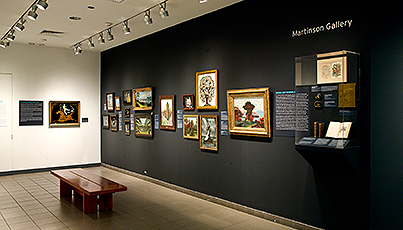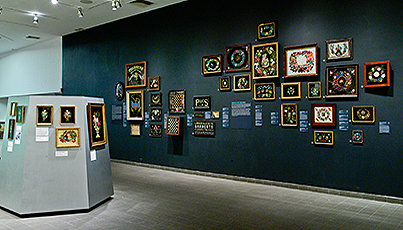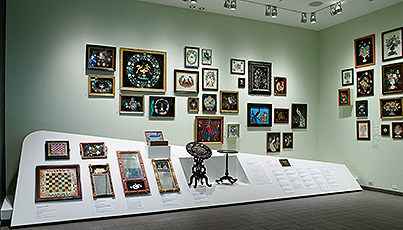URN OF FLOWERS WITH BLUE LEAVES
Artist unidentified

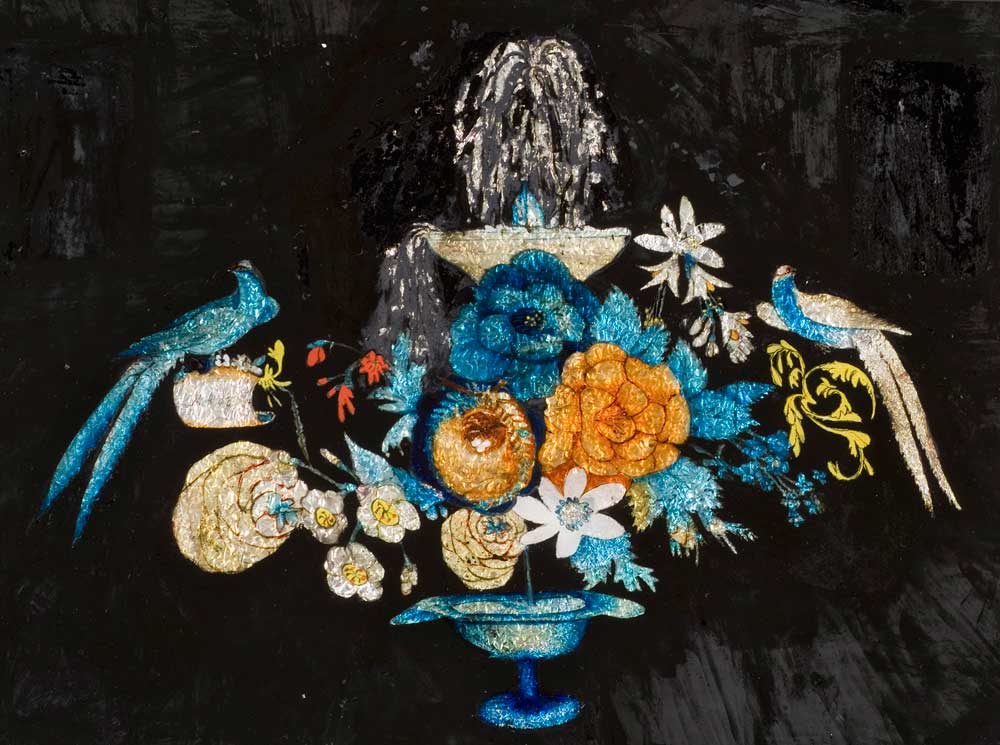

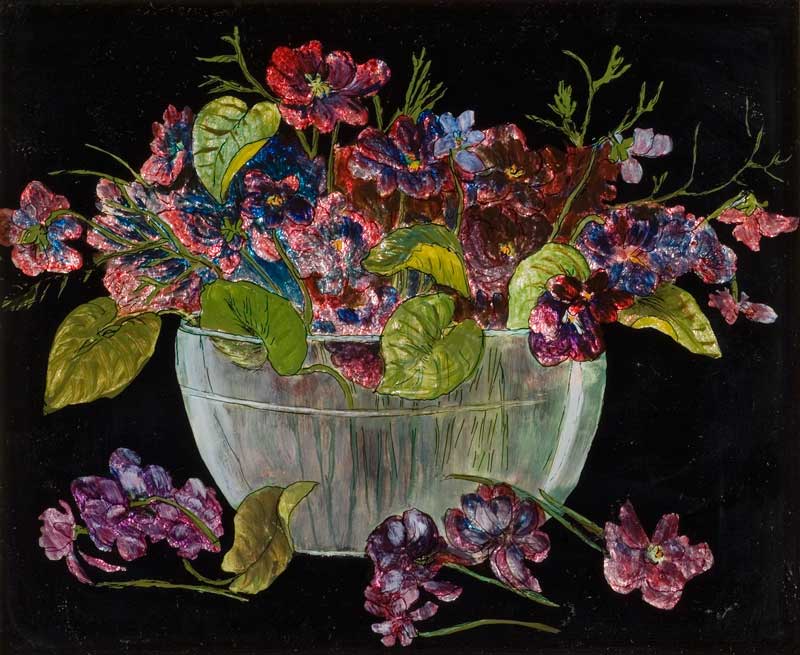
“Foiled: Tinsel Painting in America” is the most comprehensive museum exhibition to focus on this under-recognized decorative art that was widely practiced in America from 1850 to 1890. One of the great revelations of the exhibition is the way this modest technique touched upon so many aspects of American life, innovation, and culture.
Tinsel paintings are reverse paintings on glass with smooth or crumpled metallic foil applied behind translucent and transparent areas; when viewed in candlelight or gaslight, the effect was one of shimmering highlights. In the first half of the 19th century, tinsel painting was taught to young women whose parents were dedicated to providing refined education for their daughters and paid for such special classes. By the mid- to late 19th century, the art had expanded outside the school curriculum, and instructions proliferated in books and were advertised in women’s magazines. Its origins are related to forms developed in Renaissance Italy, 18th-century China and France, and 19th-century Austria, England, and Germany. Floral imagery predominates, as botanical copy prints and patterns were often employed. Especially appealing today are rare works that combine a variety of techniques and materials, including photography and collage.
It is remarkable that so many examples of this fragile art have survived. The American Folk Art Museum has in its holdings a wealth of tinsel paintings thanks to the prescience of donors Kristina Barbara Johnson and Jean and Day Krolik Jr. With a significant gift from Susan and Laurence Lerner, the museum is now the largest public repository of this fascinating artform.
“Foiled: Tinsel Painting in America” is sponsored, in part, by Joyce Berger Cowin, by public funds from the New York City Department of Cultural Affairs in partnership with the City Council, by Bloomberg Philanthropies, by the Ford Foundation, by The David Davies and Jack Weeden Fund for Exhibitions, and by the New York State Council on the Arts with the support of Governor Andrew Cuomo and the New York State Legislature.

Wreath of Flowers with Lithograph of Jenny Lind
Artist unidentified
United States
c. 1850
Reverse painting and foil on glass with lithograph
25 1/2 x 21 1/2 in. (sight)
American Folk Art Museum, gift of Susan and Laurence Lerner, 2009.13.3
Photo © 2006 Andy Duback
Jenny Lind, the “Swedish Nightingale,” made a sensation in New York when she performed at Castle Garden in 1850. The impresario P.T. Barnum brought Lind to the United States and drummed up so much anticipation that forty-thousand people arrived to greet her ship in New York harbor. The ensuing “Lindomania” made the opera singer a celebrity and a wealthy woman. The sale of a wide range of products was part of Barnum’s unprecedented campaign to promote Lind’s two-year tour. Memorabilia included sheet music, songbooks, decorative prints, valentines, greeting cards, paper dolls, tobacco packages, cigar labels, glass flasks, ceramic lamps, lockets, children’s plates, pitchers and washbowls, commemorative silver medals, printed cotton, and wallpaper. Although the source of the lithograph in this tinsel painting remains unidentified, it resembles a print of Lind posed in her role as Amina in Bellini’s opera La Sonnambula.

Compote of Flowers with Fountain and Birds
Artist unidentified
United States
c. 1859–1868
Reverse painting and foil on glass
16 x 22 in.
American Folk Art Museum, gift of Susan and Laurence Lerner, 2009.13.46
Photo © 2006 Andy Duback
This image is possibly based on two commercial patterns described in Art Recreations and offered for sale by its publisher, J. E. Tilton & Co., Boston: “We have published, for Oriental painting, two fine copies; one, a handsome wreath, with fountain, birds, etc.; the other, an elegant vase of flowers, with birds’ nests, birds, butterflies, etc.; price, eighty cents the pair, post-paid, on a roller, to any address. Also, two smaller ones, that will combine with the vase and wreath to make innumerable combinations, or may be used separately; price, thirty cents the pair; or we will send the four on one roll for one dollar, post-paid.”

Wreath of Flowers with Silhouettes of Man and Woman
Artist unidentified
United States
c. 1830s
Reverse painting and foil on glass with papercuts
13 1/2 x 19 1/4 in.
American Folk Art Museum, gift of Susan and Laurence Lerner, 2009.13.44
Photo © 2006 Andy Duback
A pair of pendant portrait silhouettes is surrounded by a heart-shaped wreath. Silhouettes were popular in the 1830s before widespread use of photography to capture a likeness and the dress and hairstyles of both the man and the woman are consistent with that era.

Family Tree with Ambrotypes
Artist unidentified
Massachusetts
c. 1888
Reverse painting and foil on glass with ambrotypes
22 1/4 x 18 1/4 in.
American Folk Art Museum, gift of Kristina Barbara Johnson, 1992.17.8
Photo by Gavin Ashworth, New York
Family histories were often maintained through hand-drawn or embroidered records that documented generations of family members. Such records usually include birth and death dates. Trees, with their many branches, were a favored symbolic element. This unusually large example combines freehand painting and ambrotypes of a family with ten children. Judging by the appearance and placement of four of the young men, there might be two sets of male twins.
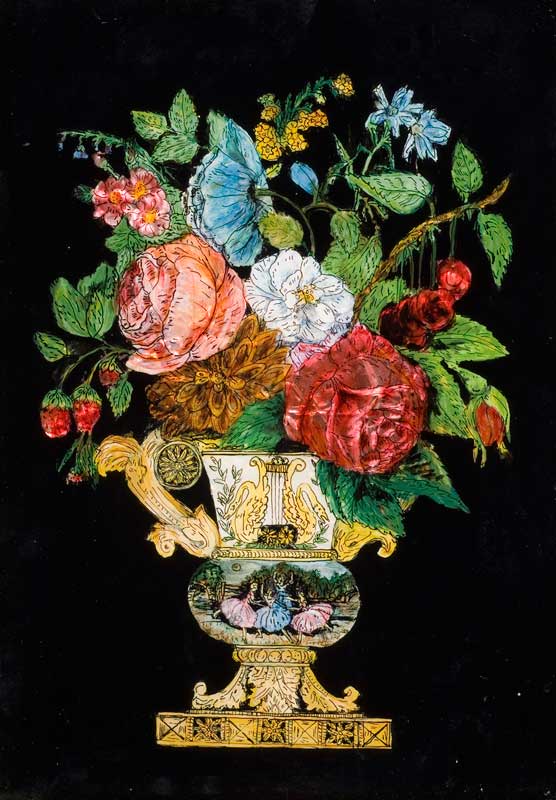
Urn of Flowers with Scene from Ballet Swan Lake
Alice Knight (1861–1963)
Hillsborough, New Hampshire
c. 1940
Reverse painting and foil on glass
15 5/16 x 11 1/2 in.
American Folk Art Museum, gift of Susan and Laurence Lerner, 2009.13.30
Photo © 2006 Andy Duback
This is one of the most exuberant and finely executed tinsel paintings in terms of color and design. Several signed tinsel paintings by Alice Knight have surfaced over the years; a glass negative of this tinsel painting exists as well as another almost identical work. The artist was born in Ludlow, England, and arrived in America in 1889. She maintained a studio and school in Hillsborough, New Hampshire, and was well known in her community for her reverse paintings on glass as well as landscapes and decorative painting on furniture and trays. Knight was engaged in artmaking up until a few years before she died.
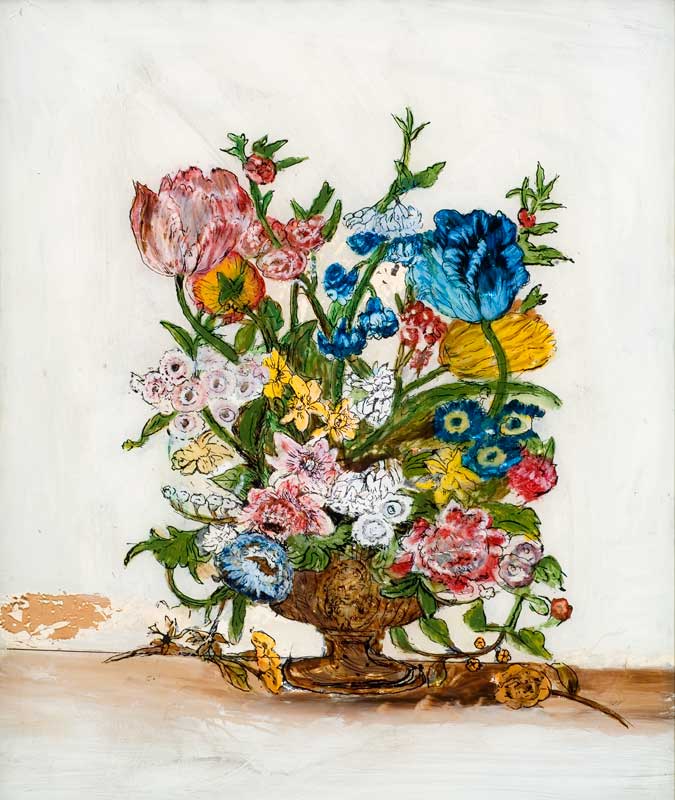
Vase of Flowers
Artist unidentified
United States
Possibly 20th century
Reverse painting and foil on glass
18 3/4 x 16 in.
American Folk Art Museum, gift of Susan and Laurence Lerner and Kohler Foundation, Inc., 2012.13.18
Photo © 2006 Andy Duback
This tinsel painting is inspired by a print from Richard Furber’s Twelve Months of Flowers, a series of floral prints based on eighteenth-century paintings by Peter Casteels that was sent to prospective clients of Furber’s nursery business. The portfolio was so popular that it was reprinted several times. In one of the reprints, the images were reversed, which might account for the deviation of this version of “April” from other folio presentations of the original painting.
“Foiled: Tinsel Painting in America” is sponsored, in part, by Joyce Berger Cowin, by public funds from the New York City Department of Cultural Affairs in partnership with the City Council, by Bloomberg Philanthropies, by the Ford Foundation, by The David Davies and Jack Weeden Fund for Exhibitions, and by the New York State Council on the Arts with the support of Governor Andrew Cuomo and the New York State Legislature.

